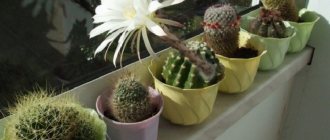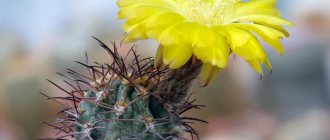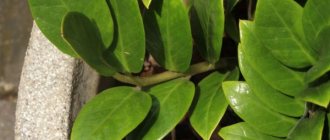Cacti always have a place indoors. Residents of the northern regions, where these amazing plants cannot survive on the streets and in gardens, are attracted to them by their unusual appearance and decorative properties. Admiring the cacti, you can’t help but feel like you’re in a hot desert or on the prairie. It is believed that plants do not need special care. But this is a deception: to grow cacti, you need to have knowledge of indoor farming techniques.
For indoor plants, soil selection is important. Each species will need its own components of the soil substrate, their proportions will vary depending on the structure of the root system. You can, of course, buy soil in a store, but will it meet the requirements? The mixtures are not always formulated correctly. Therefore, it is better to choose the composition yourself that will allow the cacti to fully develop.
Review of the best cactus varieties to grow
Cacti belong to the Carnation family. They are able to grow in deserts, places where precipitation rarely falls. Their succulent, fleshy leaves store moisture, just like succulents. The arid regions of South America and the West Indies are considered the homeland of remarkable plants. But the best types of cacti have spread throughout the world and are successfully taking up residence in apartment window sills.
Among them stands out:
- Mammillaria. They call the plant a variety of names: snowball, lady's fingers, and golden star. These spherical or columnar cacti are small in size. The growth of the fleshy stem reaches 20 centimeters. A distinctive feature of the species are the tufts of spines that protrude from closely spaced tubercles. From an early age, mammillaria begins to bloom, becoming covered with flowers of various colors.
- From large lobivia cacti. The dimensions of the cylindrical stem reach half a meter. On the surface of the stem, areas of light and dark shades of green alternate. The entire stem of the plant is decorated with spines, straight and also curved. The root is a tap or turnip-like in appearance. At the root, many children are formed, with which the lobivia reproduces. The funnel-shaped flower petals are located on the side of the stem. An adult plant opens up to 25 brightly colored buds. Another name for cactus is Echinopsis.
- Cereus is a columnar cactus. This long-liver is capable of reaching a height of up to a meter or two, and in nature – up to 6-8 meters. The straight, candle-like stems have spines. And during the growing season, white or red buds are formed.
- Prickly pear. The flat-oval fleshy stems are divided into segments. The bluish-green color of the cactus is interesting. The spines of the prickly pear are modified, and the short hairs cause trouble for those who touch the stems. They dig into the skin and are difficult to get rid of. The plant blooms from spring to autumn.
- Phyllocactus, or epiphyllum. These are leaf-shaped types of cacti, although leaves refer to the flat stems of the plant. Decorative flowers of a cactus. They are large and brightly colored. There are species with fragrant buds.
Depending on the variety of cactus, a container and soil are selected.
Soil care
The soil also requires care.
- Sterilization . The very first thing you need to do for him is sterilization. 20-30 minutes is enough for the entire soil to warm up to 100 C.
- Watering .
Water the plant depending on environmental conditions. At high temperatures, low humidity and intense sunlight, the cactus requires more liquid. Therefore, in summer, cacti, with the exception of cloudy days, need to be watered daily, with the onset of autumn, reduce watering, and in winter, reduce watering to 2 times a month. For irrigation, use rainwater or water softened by boiling at room temperature. - Feeding . Most often, the cactus is “fed” with nitrogen, potassium, phosphorus and calcium salts. Coal chips, gravel and other components are added to the soil itself in order to improve its quality.
Pests . The main pest living in the soil is the mealy root bug. This is a light-colored insect 1-2 mm long, capable of changing its location, so one infected pot poses a danger to all the others if the pots are nearby. A cactus severely affected by scale insects stops growing and drops its buds. There are two methods to combat the parasite:- Chemical - the cactus is sprayed with a systemic insecticide twice, with an interval of 14 days.
- Mechanical - the cactus and its roots are washed with warm water, after which the cactus is dried and transplanted into clean soil.
For greater effect, you can combine both methods.
As it turned out in reality, there is quite a lot of trouble with the cactus . But if this does not put off the amateur gardener, then the prickly friend will be an excellent alternative to the aloe, agaves and ficus trees that have become boring to us.
When growing a cactus, it is very important to follow all the rules for caring for this plant. If you choose a suitable pot and a good place to place it in your apartment or garden, and also feed, trim and replant your pet in a timely manner, then it will certainly delight you for a long time with its active growth and abundant flowering.
Selecting a container for a plant
You need to decide on the size of the pot for cacti in advance. The root system of plant species differs in shape and length. Mammillaria have many babies on the sides, so the volume of the pot should be 10 centimeters.
The branched roots of some species require a wide but low container. Lobivia has a long root, and a deep pot is selected for it. The material from which the cactus container is made does not play a special role. Both ordinary plastic and ceramic ones will do.
Plants should not be planted in metal containers.
Containers come in different shapes. They are all good for cactus. You can use round, or better yet, rectangular or square pots or tubs if the plant has reached a large size. A good owner always carefully monitors the condition of his “prickly friend”, promptly transplanting him from a small container to a larger one.
What are the soil requirements for growing cacti?
The optimal soil mixture for cacti should not be wet all the time, otherwise the roots will rot, which will destroy it. A good nutrient soil for your cactus is one that is easily depleted. This is why universal soil for cacti is not suitable. It is important to understand that each species has special preferences for the composition of the earth. Therefore, before choosing soil soil, you should understand several important nuances:
- thorny plants prefer loose and ventilated soil;
- all subspecies of such plants need a slightly acidic substrate, pH = 4.5 - 6 is considered the best option; if you want to get flowering, you will need to add nutrients;
- Do not apply nitrogen-based compounds to the soil, as plants will react extremely poorly to it.
The roots of cactus crops love an airy, well-drained soil mixture that dries well and is easily moistened. Do not forget about the importance of replanting crops immediately after purchase. Whatever purchased soil you use, the best soil for cacti is the one you make yourself. In universal soil, cacti often develop quite poorly.
What soil is best for cacti?
Specialized stores will offer substrate for cacti and succulents. But it is not suitable for all types of plants. The basis of the finished mixture is peat. This component is not always useful for cacti that came to us from deserts or mountains. After all, there cacti grow on dry soil, stones, sand and clay. And nutritious peat can destroy cacti, since microflora that is undesirable for cacti develops in it.
The ideal environment for desert dwellers would be one that mimics grainy, arid soil that lacks nutrients. Harsh soils and minimal precipitation are normal for cacti. They manage to develop and bloom in such conditions. Therefore, the soil must be selected taking into account the needs of indoor crops.
Post-procedure care
If everything was done correctly during transplantation, then all that remains is to properly care for the cactus. To do this, adhere to the following rules:
- After transplanting a cactus, it should never be watered. Watering begins only after 2-3 weeks. During transplantation, a small part of the roots are almost always damaged; they become sensitive to moisture and can rot and die.
- Having planted a cactus, it needs to be moved to a dark, cool place and not touched for about a week, giving it the opportunity to calmly adapt.
- Fertilizers cannot be ignored. Special fertilizers for cacti contain a small amount of nitrogen. In standard fertilizers, the percentage of nitrogen is higher, which can cause the plant to develop too actively. The succulent will not keep up with its rapid growth; damage will appear on its surface, which will subsequently begin to rot.
- Although wild cacti grow in hot deserts, you should not place a container with a plant near batteries, trying to create the most natural natural conditions. Sunlight will be enough. In winter, heat is not needed at all, since the cactus hibernates, so it should be placed in a cool, well-lit place with a temperature of at least 15 degrees.
- To prevent the plant from getting sick, it is recommended to replant it every year and treat the roots with a fungicide solution. For minor infections, cacti are treated with garlic or tobacco infusions.
After planting, special marks are made on one side of the container so that each time the plant is placed with the specific side facing the window. Cacti do not like rearrangements.
Cacti are ideal plants to plant at home. They are long-lived, have beautiful inflorescences and are not whimsical. Planting and caring for a cactus is quite simple. With their charming blooms, they can complement the interior of a home or office. This plant will delight its owner with beautiful inflorescences every year. The main thing is not to forget to water it on time.
How to properly prepare soil at home?
The main components of mixtures for cacti will be:
- clay-turf soil
- leaf soil
- coarse sand or fine gravel
- mineral component
Clay-turf soil can be found in meadows in the floodplains of rivers, near reservoirs. It is light brown in color and heavy in structure. Leaf soil is taken from parks, gardens, and forests. Pronounced black color indicates decomposition products of plants and leaves. The soil is nutritious and loose.
Sand of the required structure is found on river banks or in quarries. Vermiculite and expanded clay are suitable mineral components. You can replace them with brick chips and crushed charcoal. The substrate for cacti is made up of two parts of turf and leaf soil, three parts of sand and one part of mineral components. Of the fertilizers, cacti require more potassium. If the root system of the cactus is turnip-like, then increase the amount of vermiculite to 60 percent of the total mass of the substrate.
The finished mixture is checked: it should be loose, permeable, slightly moist, and after being compressed into a lump it crumbles easily.
Interestingly, cacti with pubescence and spines need chalk or marble chips in the soil. Leaf cacti require more nutritious soil, so you can add humus to the pot, excluding minerals containing calcium and magnesium. When the soil for cacti at home is prepared correctly, the plant will develop and bloom without problems.
How to make a substrate with your own hands?
To prepare a planting mixture for cacti, you need to take one part clay soil, two parts peat, two parts each sand, leaf soil, gravel and coarse river sand.
- Peat and two types of soil are sifted through a sieve.
- Small pebbles and sand are cleaned of impurities and washed.
- The brick chips are first washed to remove dust, then treated for disinfection with a solution of sulfuric acid, and then washed again with water.
- All components are mixed.
- Fertilizers are added to 10 kg of the mixture: potassium phosphate and superphosphate (proportional ratio 3:1).
- The soil mixture is heated in a water bath to destroy all harmful microorganisms. Pour the mixture into a pan that is not covered with a lid, place it in another container, larger, filled 1/3 with water and keep it on low heat for an hour, adding water if necessary. Then the dishes with the soil are removed, covered with a lid and cooled.
- And:
- The bottom layer must be drainage: crushed bricks, small pebbles or stone chips are laid in such a way as to form a layer at least 1 cm high.
- The main layer is the prepared soil mixture.
- And the third, top layer is surface drainage, which can consist of brick or stone chips, expanded clay or perlite.
It is better to use old lowland peat to acidify and loosen the soil. The mixture is prepared about a month before the planned planting of cacti.
Additional components (lime, eggshells, dolomite flour, etc.) are added depending on the specific type of cactus, as well as the characteristics of the initially selected soil.
Video about preparing soil for a cactus and its further replanting:
Growing cacti largely depends on properly prepared soil. It is best to make the soil mixture yourself, taking into account the species characteristics of the plant. It is necessary to add other components suitable for a particular variety to the ready-made substrate purchased in the store.
Rules for planting indoor crops
It is better to plant or replant a cactus in April or May. A layer of drainage is placed in the container, and then a little prepared soil.
It is advisable to disinfect the soil mixture before planting.
You can spill boiling water on the soil two weeks before planting the plant. Steaming in the oven cannot be ruled out by placing the container in a slightly heated cabinet for an hour. A microwave oven is also used for these purposes. In any case, the procedure is carried out in advance so that the earth has time to be saturated with beneficial organisms.
The roots of the cactus are straightened, lowered into the pot and sprinkled with soil. After lightly compacting and watering, you need to add soil and a drainage layer on top. Cacti are replanted twice a year, choosing a new pot and substrate.
Picking cacti or replanting them
Cacti cannot stay in one pot for a long time. Despite the fact that they grow quite slowly, after the young growth has reached a diameter of 5 mm, it must be picked (replanted), otherwise the plants will become crowded and they will stop growing.
The procedure is performed almost the same way as when planting shoots. The only difference is that you should protect your hands from needles and needles from your hands.
Important! Under no circumstances should you damage a young cactus, because it can get sick and die.
Therefore, during transplantation, it is necessary to use either tweezers and use them to pull out young cacti, or wrap the plants with something. The disadvantage of the first method is that there is a risk of breaking the cactus during extraction. That's why everyone uses the second method - wrapping. For these purposes, you can use a towel, soft sponges, or simply wear rubber gloves.
In the first year, picking is performed quite often, because during the procedure the roots of the plant break off a little, at the same time lateral shoots are formed, and due to this, the young growth begins to grow well.
During transplantation, it is important to ensure that the substrate in the pot from which the cactus is removed is dry. This will make it easier to remove the plant from the pot.
Despite the fact that the process is quite labor-intensive, it is often resorted to, this is due to the fact that the quality of such cacti (grown from seeds and then picked) is much higher than those grown from shoots. By the way, they are also easier to care for. Some gardeners note that such plants have better resistance to diseases and pests.
During planting, it is important to pay attention to ensure that the cactus is not buried too deep into the soil mixture. At the same time, it should not rise above the ground so that the plant can be seen from afar.
Some gardeners, in order to highlight the cactus, if they really want to, use a flowerpot in which they place their flower. During the flowering period it actually looks incredibly beautiful.
Options for growing succulents
Fans of desert plants often want to breed new species. But it is rare that you can purchase a cutting or part of a plant for propagation. Therefore, lovers of exotic plants are faced with the question: “How to plant succulents?”
Vegetative propagation
Cymbidium orchid: options for growing and caring at home
You can grow succulents either from seeds or plant parts. Many types of succulents produce daughter plants on stems. This most often occurs in cacti. You can remove such a plant from the mother plant only after it is fully formed. The signal for this is the gradual detachment of the bottom of the new plant from the mother’s stem.
Other types of succulents are propagated from cuttings or leaves. These parts of the plant can be planted almost immediately into succulent soil.
Important! It is not advisable to root cuttings and leaves in water. This can lead to their rotting.
Many plants in hot and dry countries shed their leaves to reproduce. One such species is Crassula. If a fallen leaf is left on the soil, after a few weeks it will take root and a new plant will begin to develop.
It is better to plant succulents from cuttings in the spring. At this time, they take root well and will get stronger over the summer.
From seeds
Exotic species can only be grown from seeds. You can buy them either in a regular flower shop or order them from an online store.
You can grow succulents from seeds either by following the recommendations of gardeners or by taking into account some of the peculiarities of the propagation of cacti and succulents.
You can germinate seeds using a special container with a transparent lid. You can buy such a container in a store.
Important! There should be small boxes inside the container for planting. Be sure to make drainage holes in the bottom of the pots.
It is best to germinate succulent seeds in a mineral base: a mixture of gravel, sand and perlite. Seeds of plants such as aloe or gasteria are best sown in perlite.
After distributing the substrate among the pots, take a thick sheet of paper and fold it in half. Seeds are poured into the resulting fold and, lightly tapping the folds, they are evenly distributed over the surface of the soil.
When all the seeds are distributed over the surface, they are sprinkled with a layer of sand no more than 2 mm. In this way, you can plant succulents with both large and small seeds.
Important! The covering layer should not exceed the size of the seeds. Very small seeds are not sprinkled at all.
The crops are watered with settled water at room temperature. In order not to wash away the seeds, they need to be watered by spraying from a spray bottle. After watering, cover the container with a transparent lid or film.
The greenhouse begins to be removed after the emergence of seedlings. The hardening time is gradually increased and the cover is removed after the plants reach a size of 2 cm.
Sprouted seeds
When growing succulents from seeds, be patient. Each species has different germination times. Some seeds germinate in 90 days. All this time the soil must be kept moist.
New seedlings can be planted after the seedlings have become stronger and are at least 5 cm in height. Some species require several months for this, while others take a year.
Ready substrate for succulents
Trademarks produce many ready-made soil mixtures. Professional florists and amateurs buy them in flower salons, garden and garden supply stores.
Before purchasing a specific soil, it is recommended to carefully study its composition and properties. Manufacturers are not always conscientious when composing the mixture. This leads to the rapid death of the plant.
It is important to remember that the nutrient substrate for succulents has its own distinctive characteristics. Almost all companies that produce soil for planting aloe, crassula, and cacti use an ingredient such as peat in the mixture.
This substance has the ability to increase the acidity level of the soil, which is stabilized by dolomite flour. Sellers use:
- Lowland peat. The material tracks well. It is combined with fine expanded clay and sand, which are used to loosen the earth.
- Supreme peat. Retains moisture for a long time and is difficult to wet after drying.
Among the popular ready-made mixtures for succulents are such products as “Biagro” and “Seliger-Agro”. They contain both highland and lowland peat.
If you choose the Bereginya substrate, please note that it contains compost. If you prefer to plant cacti, then the Vermion mixture, which contains vermicompost, will be ideal for them.
What is soil microflora?
Soil microflora - microscopic fungi, bacteria and algae. For life, they need organic components of the substrate. In addition to organic matter, they require stable conditions so that the soil does not dry out completely.
When growing ordinary plants, microorganisms receive exactly these conditions: the soil remains constantly moist.
Plant roots can also serve as a substrate for soil microbes, but ordinary plants know how to protect themselves from this. Not succulents. For them, the best prevention against rotting is the use of mineral soils, small pots, and watering only after the soil has completely dried out and been in a dry state for some time.
What should you pay attention to?
The first thing you need to find out before preparing the soil is what species this or that plant belongs to, and what environment is most comfortable for it. It is best to focus on the “native” climate zone of the succulent. Thus, representatives of desert and high-mountain flora (prickly pear, rebutia, astrophytum, echinopsis, ariocarpus) will feel better in a completely mineral substrate of sand and stones, but forest guests from the jungle or savannah (Decembrist, epiphyllum, ripsalidopsis, weberocereus) will benefit Use turf, deciduous soil, sphagnum moss, charcoal, pieces of bark.
97fce818a0b9c416596b3843ca87949c-terrarium-cactus-cactus-plants.jpg
Cacti originating from rocky regions need more calcium - for this, lime, chalk, and crushed eggshells are added to the mixture. However, only round plants with many needles will respond well to this kind of feeding, but elongated leafy ones can get sick.
dikie-kaktusy.jpg
When planting young plants or shoots (“babies”), it is recommended to add up to 50% organic soil, regardless of the characteristics of a particular species. This can be regular molehill soil found in the garden, or a standard succulent substrate. The second part of the substrate should include fine gravel, sand, clay granules, zeolite, perlite, etc.
5c21f1b31f1275c21f1b321a34.jpg
By the way
In all literature, lime or old plaster is always added to the list of soil ingredients. I deliberately do not include it in soil mixtures, as I have learned from my own experience that it must be handled very carefully.
In the sense that excess lime is very harmful to cacti, first of all, suberization of the root part of the stem is observed, even in cases where lime was not added to the soil, its excess occurs due to its high content in water.
Thus, it makes sense to add lime to the soil of those cacti that are watered with very soft water.
Soil components for cacti: types and photos
The need to abandon peat and other organic matter is perceived painfully by some cactus growers, since it is not clear where the plant will get its nutrients from. Worries about this are in vain, because the roots of desert thorns have long learned to extract the necessary trace elements from minerals and dust carried by equatorial winds. Chernozem creates unusual, even extreme conditions - it contains many bacteria to which cacti have no immunity, and with a long absence of watering, such soil turns into a solid lump without the slightest access to air or water.
ce7fbd.jpg
Suitable soil ingredients for succulents are:
Sand, especially river sand, is a mandatory filler for pots for cacti. It can be purchased in aquarium departments, or collected at the bottom of a reservoir and washed thoroughly in a fine sieve.
rechnoy_pesok.jpg
Clay granulate (akadama, ceramis) is red clay baked in the form of finely porous lumps 2-5 mm in size. Unlike the usual one, it does not stick together when wet, but retains its shape and begins to collapse only after 2 years. When planting cacti in such granules, other additives are no longer required, but as the soil loses its looseness, it will have to be replaced.
granulyat_seramis.jpg
Expanded clay is foamed ceramic balls with a diameter of 0.5 to 4 cm. As a rule, a drainage layer is made from it at the bottom of the container. Fine grains can also be used as a soil composition for large cacti.
keramzit_drenazh.jpg
Perlite is a volcanic rock of minerals with a porous texture. Formed from solidified lava under the influence of water. In floriculture, agroperlite of 1-5 mm is used, the function of which is to make the soil lighter, improve air exchange, absorb excess moisture and slowly release it as it dries.
perlit.jpg
Zeolite is a crystalline sodium and calcium silicate that has the ability to selectively adsorb and release various substances. Thus, these pebbles not only structure the soil, but also perform an important function as a natural filter during irrigation.
64521139.jpg
In addition to all of the above, you can add ordinary mountain sand, red brick chips (this is also baked clay), mineral fillers for cat litter, aquarium soil, fine pumice, and vermiculite to the soil for cacti.
5d46827a503755d46827a503b7.jpg
To protect the base of the succulent from contact with wet soil immediately after watering, the surface is sometimes covered with a layer (0.5-1 cm) of some decorative stones - pebbles, gravel, artificial colored crushed stone. This design looks very attractive, but can slow down the drying process and make it somewhat difficult to monitor the condition of the substrate.











